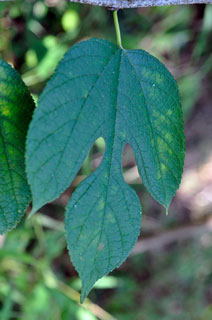RED MULBERRY
|
 |
| File Size: 71 KB |
|
|
|
Morus rubra L.
|
| Wildcat Glades Conservation & Audubon Center, Newton County, Missouri |
| Height: To 72 feet |
| Family: Moraceae - Mulberry Family |
| Flowering Period: April, May |
|
| Trunks: | | Erect; branches unarmed; bark grayish brown to reddish brown, furrows shallow, ridges broad, flat; wood reddish brown, soft. | | Twigs: | | Greenish brown to reddish brown, flexible, smooth, glabrous or sparsely pubescent; leaf scars elliptic to oval; sap milky; buds dark brown, ovoid, .12 to .28 inch, apex acute, scales pubescent and ciliolate. | | Leaves: | | Alternate, simple, deciduous, highly variable; petiole .8 to 1.2 inch long, glabrous or pubescent; blade broadly ovate, 4 to 12 inches long, 3.2 to 6 inches wide, entire to irregularly 3-5-lobed; upper surface dark green, smooth or usually rough; lower surface paler, minutely pubescent along veins; margins coarsely toothed; lateral veins curve and join neighboring veins near margin; small vein extends to each tooth tip; leaf tip abruptly tapering to point; base rounded to heart-shaped. | | Flowers: | | Catkins; staminate catkins in leaf axils on new growth, drooping, 10-40-flowered, .8 to 12 inches; peduncles .16 to .6 inch; pedicels absent; pistillate catkins in leaf axils of new growth, drooping to spreading or erect, cylindric, 5-30-flowered, .3 to .8 inch; peduncles .12 to .2 inch, pedicels absent. Flowers unisexual, more or less radially symmetric; staminate: sepals 4, connate proximally, calyx lobes green often tinged red, ovate to elliptic, .08 to .1 inch, adaxially pubescent, distally ciliate, apex acute; petals absent; stamens 4; pistillate: sepals 4, somewhat connate, calyx becoming fleshy in fruit, lobes ovate, distally ciliate, apex acute; petals absent; pistil 1, ovary superior, 2-locular; styles 2. | | Fruit: | | June and July; multiple, dark purple, .6 to 1 inch long, .24 to .47 inch thick, glabrous, fleshy; achene 1 per ovary, yellow or tan, flattened-ovoid, .08 to .1 inch. | | Habitat: | | Stream banks, moist woods, river bottoms, wooded flood plains; usually in moist soils. | | Distribution: | | East 4/5 of Kansas | | Origin: | | Native | | Toxicity: | | The unripe fruit and sap have low levels of toxicity when eaten. | | Uses: | | Often planted in windbreaks. Native Americans and pioneers ate the fruits raw or dried and used the berries to make juice and jam. The sun or fire dried fruits were preserved for winter use and used as food when hunting. An infusion of bark was used to treat dysentery and worms and an infusion of roots taken for urinary disorders. Mulberry sap was rubbed on ringworm and bows were made from the wood. | | Comments: | | Mulberry is an understory tree. The wood is light, soft, coarse-grained, pale orange, and is very durable. It was used in the past to make fence posts. The leaves on the same tree may be entire or deeply lobed. | | | | See white mulberry |
|
| Red mulberry leaf |  | | 79 KB | | Wildcat Glades Conservation & Audubon Center, Newton County, Missouri |
| | Red mulberry leaf |  | | 81 KB | | Wildcat Glades Conservation & Audubon Center, Newton County, Missouri |
| | Red mulberry bark |  | | 53 KB | | Wildcat Glades Conservation & Audubon Center, Newton County, Missouri |
| | Red mulberry leaves |  | | 110 KB | | Wildcat Glades Conservation & Audubon Center, Newton County, Missouri |
| | Red mulberry leaf veins |  | | 89 KB | | Wildcat Glades Conservation & Audubon Center, Newton County, Missouri |
| | Red mulberry bark |  | | 135 KB | | Johnson County, Kansas |
| | Red mulberry staminate inflorescence |  | | 74 KB | | Johnson County, Kansas |
| | Red mulberry staminate inflorescence |  | | 67 KB | | Johnson County, Kansas |
| | |
|
|
|